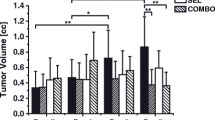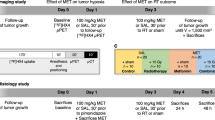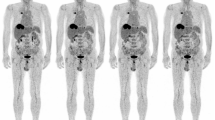Abstract
Purpose
Quantification in positron emission tomography (PET) imaging of an orthotopic mouse model of colorectal cancer (CRC) is challenging due to difficult tumor delineation. We aimed to establish a reproducible delineation approach, evaluate its feasibility for reliable PET quantification and compare its added translational value with its subcutaneous counterpart.
Procedures
A subcutaneous Colo205-luc2 tumor fragment harvested from a donor mouse was transplanted onto the caecum of nude mice, with (n = 10) or without (n = 10) the addition of an X-ray detectable thread. Animals underwent 2-deoxy-2-[18F]fluoro-D-glucose ([18F]FDG) PET imaging, complemented with X-ray computed tomography (CT) and magnetic resonance imaging (MRI, 7T). Animals without a thread underwent additional contrast enhanced (Exitron) CT imaging. Tumors were delineated on the MRI, μPET image or contrast enhanced μCT images and correlations between in vivo and ex vivo [18F]FDG tumor uptake as well as between image-derived and caliper-measured tumor volume were evaluated. Finally, cancer hallmarks were assessed immunohistochemically for the characterization of both models.
Results
Our results showed the strongest correlation between both in vivo and ex vivo uptake (r = 0.84, p < 0.0001) and image-derived and caliper-measured tumor volume (r = 0.96, p < 0.0001) when the tumor was delineated on the MR image. Orthotopic tumors displayed an abundance of stroma, higher levels of proliferation (p = 0.0007), apoptosis (p = 0.02), and necrosis (p < 0.0001), a higher number of blood vessels (p < 0.0001); yet lower tumor hypoxia (p < 0.0001) as compared with subcutaneous tumors.
Conclusions
This orthotopic mouse model proved to be a promising tool for the investigation of CRC through preclinical imaging studies provided the availability of anatomical MR images for accurate tumor delineation. Furthermore, the tumor microenvironment of the orthotopic tumor resembled more that of human CRC, increasing its likelihood to advance translational nuclear imaging studies of CRC.





Similar content being viewed by others
References
Torre LA, Bray F, Siegel RL et al (2015) Global cancer statistics, 2012. CA-Cancer J Clin 65:87–108
Wilson PM, Labonte MJ, Lenz H-J (2010) Molecular markers in the treatment of metastatic colorectal cancer. Cancer J 16:262–272
Jung J (2014) Human tumor xenograft models for preclinical assessment of anticancer drug development. Toxicol Res 30:1–5
Teicher BA (2006) Tumor models for efficacy determination. Mol Cancer Ther 5:2435–2443
Morton CL, Houghton PJ (2007) Establishment of human tumor xenografts in immunodeficient mice. Nat Protoc 2:247–250
Talmadge JE, Singh RK, Fidler IJ, Raz A (2007) Murine models to evaluate novel and conventional therapeutic strategies for cancer. Am J Pathol 170:793–804
Johnson JI, Decker S, Zaharevitz D et al (2001) Relationships between drug activity in NCI preclinical in vitro and in vivo models and early clinical trials. Br J Cancer 84:1424–1431
Rubio-Viqueira B, Hidalgo M (2009) Direct in vivo xenograft tumor model for predicting chemotherapeutic drug response in cancer patients. Clin Pharmacol Ther 85:217–221
Hackl C, Man S, Francia G et al (2012) Metronomic oral topotecan prolongs survival and reduces liver metastasis in improved preclinical orthotopic and adjuvant therapy colon cancer models. Gut 62:259–271
Bibby MC (2004) Orthotopic models of cancer for preclinical drug evaluation. Eur J Cancer 40:852–857
Hoffman RM (1999) Orthotopic metastatic mouse models for anticancer drug discovery and evaluation: a bridge to the clinic. Investig New Drugs 17:343–359
Tseng W, Leong X, Engleman E (2007) Orthotopic mouse model of colorectal cancer. JoVE 10:484
Tseng WW, Winer D, Kenkel JA et al (2010) Development of an orthotopic model of invasive pancreatic cancer in an immunocompetent murine host. Clin Cancer Res 16:3684–3695
Pavese J, Ogden IM, Bergan RC (2013) An orthotopic murine model of human prostate cancer metastasis. JoVE 79:e50873
Haldorsen IS, Popa M, Fonnes T et al (2015) Multimodal imaging of orthotopic mouse model of endometrial carcinoma. PLoS One 10:e0135220
Cao HST, Kaushal S, Snyder CS et al (2010) Real-time imaging of tumor progression in a fluorescent orthotopic mouse model of thyroid cancer. Anticancer Res 30:4415–4422
Yahyanejad S, Granton PV, Lieuwes NG, et al. (2015) Complementary use of bioluminescence imaging and contrast-enhanced micro-computed tomography in an orthotopic brain tumor model. Mol Imaging
Partecke IL, Kaeding A, Sendler M, et al. (2011) In vivo imaging of pancreatic tumours and liver metastases using 7 Tesla MRI in a murine orthotopic pancreatic cancer model and a liver metastases model. BMC Cancer
Eisenhauer EA, Therasse P, Bogaerts J et al (2009) New response evaluation criteria in solid tumours: revised RECIST guideline (version 1.1). Eur J Cancer 45:228–247
Weber DC, Zilli T, Buchegger F et al (2008) [(18)F]Fluoroethyltyrosine- positron emission tomography-guided radiotherapy for high-grade glioma. Radiat Oncol 3:44
Van den Abbeele AD (2008) The lessons of GIST-PET and PET/CT: a new paradigm for imaging. Oncologist 13:8–13
Kircher MF, Hricak H, Larson SM (2012) Molecular imaging for personalized cancer care. Mol Oncol 6:182–195
Mees G, Vangestel C, Dierckx R et al (2010) Carbonic anhydrase IX expression correlates with FDG uptake by primary non-small cell lung cancer. Cancer Biother Radiopharm 25:149–154
Maeda K, Chung YS, Takatsuka S et al (1995) Tumour angiogenesis and tumour cell proliferation as prognostic indicators in gastric carcinoma. Br J Cancer 72:319–323
Mannheim JG, Schlichthaerle T, Kuebler L et al (2016) Comparison of small animal CT contrast agents. Contrast Media Mol Imaging 11:272–284
Boll H, Nittka S, Doyon F et al (2011) Micro-CT based experimental liver imaging using a nanoparticulate contrast agent: a longitudinal study in mice. PLoS One 6:e25692
Nebuloni L, Kuhn GA, Mueller R (2013) A comparative analysis of water-soluble and blood-pool contrast agents for in vivo vascular imaging with micro-CT. Acad Radiol 20:1247–1255
Wathen CA, Foje N, van Avermaete T et al (2013) In vivo X-ray computed tomographic imaging of soft tissue with native, intravenous, or oral contrast. Sensors 13:6957–6980
Wahl RL (2004) Why nearly all PET of abdominal and pelvic cancers will be performed as PET/CT. J Nucl Med 45:82S–95S
Céspedes MV, Espina C, García-Cabezas MA et al (2007) Orthotopic microinjection of human colon cancer cells in nude mice induces tumor foci in all clinically relevant metastatic sites. Am J Pathol 170:1077–1085
De Bruycker S, Vangestel C, Van den Wyngaert T et al (2016) Baseline [18F]FMISO μPET as a predictive biomarker for response to HIF-1α inhibition combined with 5-FU chemotherapy in a human colorectal cancer xenograft model. Mol Imaging Biol 18:606–616
Mukaida N, Sasaki S (2016) Fibroblasts, an inconspicuous but essential player in colon cancer development and progression. World J Gastroenterol 22:5301–5316
Love C, Tomas MB, Tronco GG, Palestro CJ (2005) FDG PET of infection and inflammation. Radiographics 25:1357–1368
Rajput A, Agarwal E, Leiphrakpam P et al (2013) Establishment and validation of an orthotopic metastatic mouse model of colorectal cancer. ISRN Hepatol 2013:206875
Acknowledgements
The authors thank Philippe Joye and Caroline Berghmans of the Molecular Imaging Center Antwerp as well as Johan Van Audekerke of the Bio-Imaging Lab for their valuable technical assistance. This work was funded by the University of Antwerp through a Bijzonder Onderzoeksfond for S.R. (BOF27327) and the iMinds ICON project FIAT (functional image analysis of tumors) for J.V., M.V. and R.H. Si.S and C.V. are supported by the Innovative Medicines Initiative Joint Undertaking (www.imi.europa.eu) under grant agreement number 115151, resources of which are composed of financial contribution from the European Union’s Seventh Framework Program (FP7/2007-2013) and EFPIA companies’ in-kind contribution.
Author information
Authors and Affiliations
Corresponding author
Ethics declarations
Conflict of Interest
The authors declare that they have no conflict of interest.
Electronic supplementary material
ESM 1
(PDF 269 kb)
Rights and permissions
About this article
Cite this article
Rapic, S., Vangestel, C., Verhaeghe, J. et al. Characterization of an Orthotopic Colorectal Cancer Mouse Model and Its Feasibility for Accurate Quantification in Positron Emission Tomography. Mol Imaging Biol 19, 762–771 (2017). https://doi.org/10.1007/s11307-017-1051-4
Published:
Issue Date:
DOI: https://doi.org/10.1007/s11307-017-1051-4




